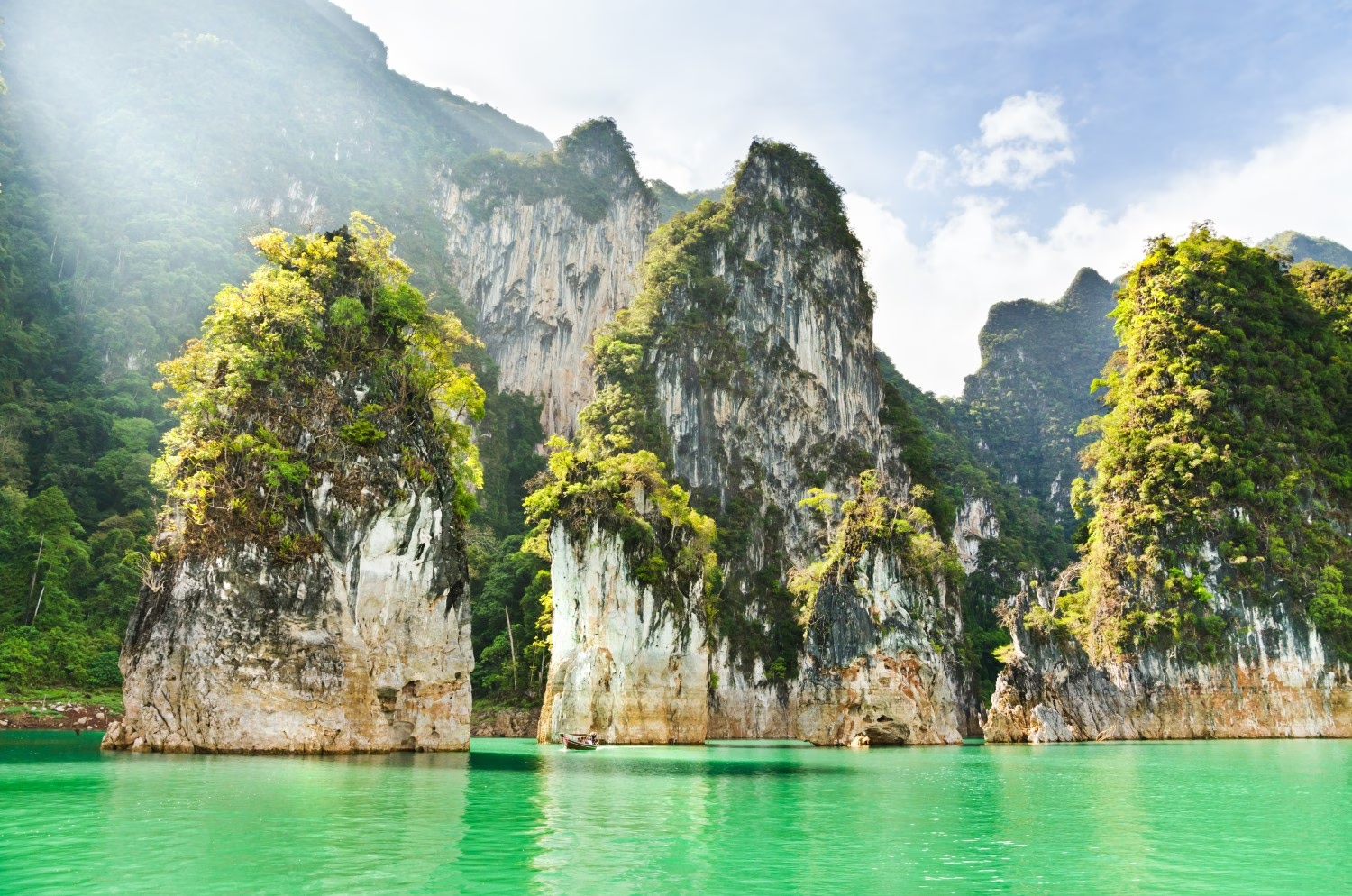Khao Sok National Park in southern Thailand is a destination like no other – a place of ancient rainforests, looming limestone cliffs, and a vast emerald lake dotted with floating bungalows. Often called Thailand’s best-kept secret, this park offers a mix of serene natural beauty and wild adventure that leaves visitors in awe. In fact, Khao Sok protects one of the world’s oldest rainforests (estimated over 160 million years, older than the Amazon!) and teems with unique wildlife.
From longtail boat rides on misty Cheow Lan Lake at dawn to trekking through dense jungle to hidden caves, a trip here feels like stepping into a lost world. We recently experienced an unforgettable two-day tour to Khao Sok from Phuket – complete with cave explorations, rainforest hikes, and an overnight stay in a floating raft house – and this comprehensive guide shares everything you need to know to plan your own adventure.
Why Visit Khao Sok?
Simply put, it’s one of Thailand’s most stunning natural paradises. Picture yourself gliding across a glassy lake flanked by karst mountains, exploring a jungle believed to be the oldest evergreen rainforest on earth, and falling asleep to the symphony of cicadas under a canopy of stars. Khao Sok offers a rare combination of peaceful scenery and thrilling activities. It’s a place to disconnect from city life (there’s no phone signal at the lake, which we found surprisingly liberating) and reconnect with nature – whether you’re kayaking at dawn, listening for gibbon calls echoing from the treetops, or cooling off under a waterfall deep in the jungle. If you crave a mix of adventure and tranquility, Khao Sok will exceed your expectations. No wonder many travelers call it a highlight of their Thailand trip!
Getting to Khao Sok National Park
Khao Sok is tucked away in Surat Thani Province, about 150 km north of Phuket. The park is accessible by road from several major hubs in southern Thailand. Here are common ways to get there:
- From Phuket: We traveled by minivan from Phuket, a journey of roughly 3 hours to the Khao Sok area. Public buses also run from Phuket’s Bus Terminal to Khao Sok Village, and many tours (like ours) include pick-up in Phuket for convenience.
- From Krabi or Ao Nang: It’s about 2–3 hours by road as well. There are daily buses and private transfers available. Some travelers combine Khao Sok with Krabi or Khao Lak in their itinerary, since it lies between these destinations.
- From Surat Thani: Surat Thani is the nearest city with an airport and train station. The drive from Surat Thani town or airport to Khao Sok is about 2 hours. If you’re coming by overnight train from Bangkok to Surat Thani, you can connect onward by bus or pre-arranged shuttle.
- By Train from Bangkok: Overnight trains from Bangkok’s Hualamphong to Surat Thani’s Phun Pin station typically arrive around 7:30 AM. Options include Rapid (167), Express (85), and Special Express (39, 41). Book a first-class sleeper, if available, for added comfort, and then transfer by bus or shuttle to Khao Sok.
- Tours with Transport: An easy option is to book a tour that includes round-trip transport from popular tourist areas (Phuket, Krabi, Khao Lak, etc.). We opted for a guided tour from Phuket with our partners at Happy Tours Phuket, allowing us to relax and not worry about the logistics. The tour picked us up early in the morning from our hotel, which was super convenient.
Most routes lead first to Khao Sok Village (also called Khlong Sok) near the park headquarters, or directly to the Ratchaprapha Dam pier (for lake tours). If you go to the village independently, you can stay in a guesthouse there and arrange lake tours or hikes locally. If your priority is the lake and you’re on a tour, you might go straight to the dam pier. In our case, after a scenic drive through rural areas and limestone karst landscapes, we arrived at the Cheow Lan Lake pier around mid-morning, ready to begin our lake adventure.
🎖️ Must Try Tour
- Location5
- Amenities5
- Services5
- Price4.75
- Rooms4.5
Our Khao Sok Tour Experience (3 Days from Phuket)
To give you a taste of what a 3-day/2-night Khao Sok tour is like, here’s how our itinerary unfolded:
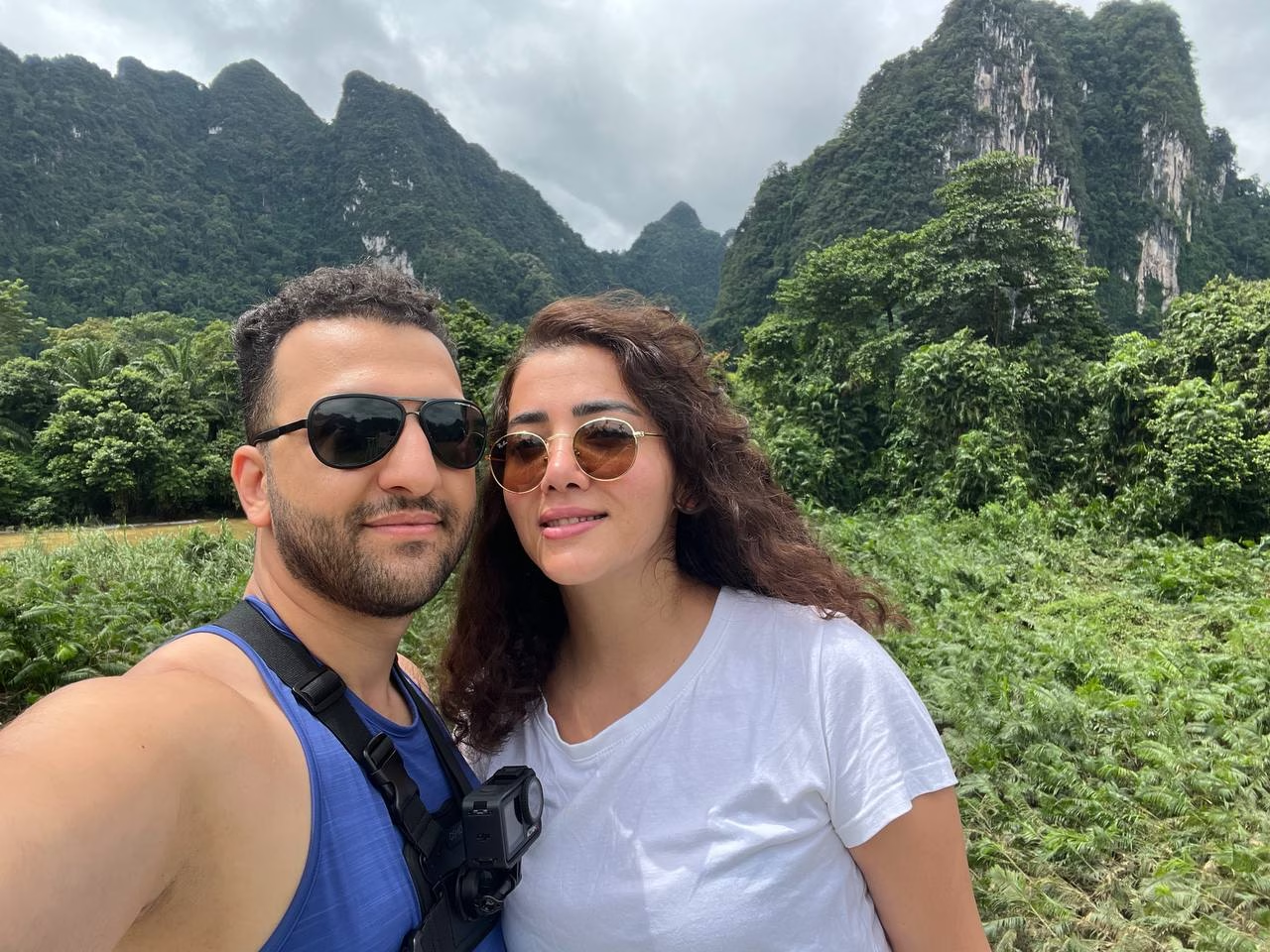
Day 1 — Phuket ➝ Khao Sok: Elephant home, monkey temple, jungle bamboo dinner
We were picked up right at our hotel in a clean, air-conditioned van and cruised about three hours to the Khao Sok area; easy, scenic highway miles with those limestone bluffs getting taller as we got closer.
Ethical elephant stop (Buathong Elephant Home)
On the way, we visited Buathong Elephant Home, where the focus is on no riding and gentle, hands-on care, feeding, and bathing in the river with plenty of time to learn the elephants’ stories from their mahouts. We met a sweet young lady elephant (her name translates to “Banana Leaf”), helped wash her in the rain (she “thanked” us with trunk-sprays), and fed her bananas and fruit—pure joy. The team even snapped a photo, printed and framed it on the spot, and gifted it to us as a keepsake. If you include an elephant experience, look for places that advertise no riding, no chains, and structured enrichment; Buathong offers exactly that kind of short, respectful encounter.
“Mother-in-Law” waterfall (Mae Yai)
Next up was Mae Yai Waterfall, nicknamed the mother-in-law waterfall locally. It’s the easiest waterfall to reach by road in Khao Sok—right off Highway 401—and looks its best in the rainy season, when a 30-meter sheet of water pours over the cliff. It’s a quick, refreshing stop that breaks up the drive beautifully. (Only in the rainy seasons where the water flow is notable).
Monkey temple near Khlong Sok
We also dropped by the area’s little “monkey temple”—a cave-temple complex where macaques hang around the forested edges hoping for fruit. Locals treat the monkeys as cheeky guardians of the grounds, and you’ll often see people offering food as a merit-making gesture before stepping into the small cave shrine with Buddha images. (Hold snacks tight; they’re adorable, fast, and not shy.)
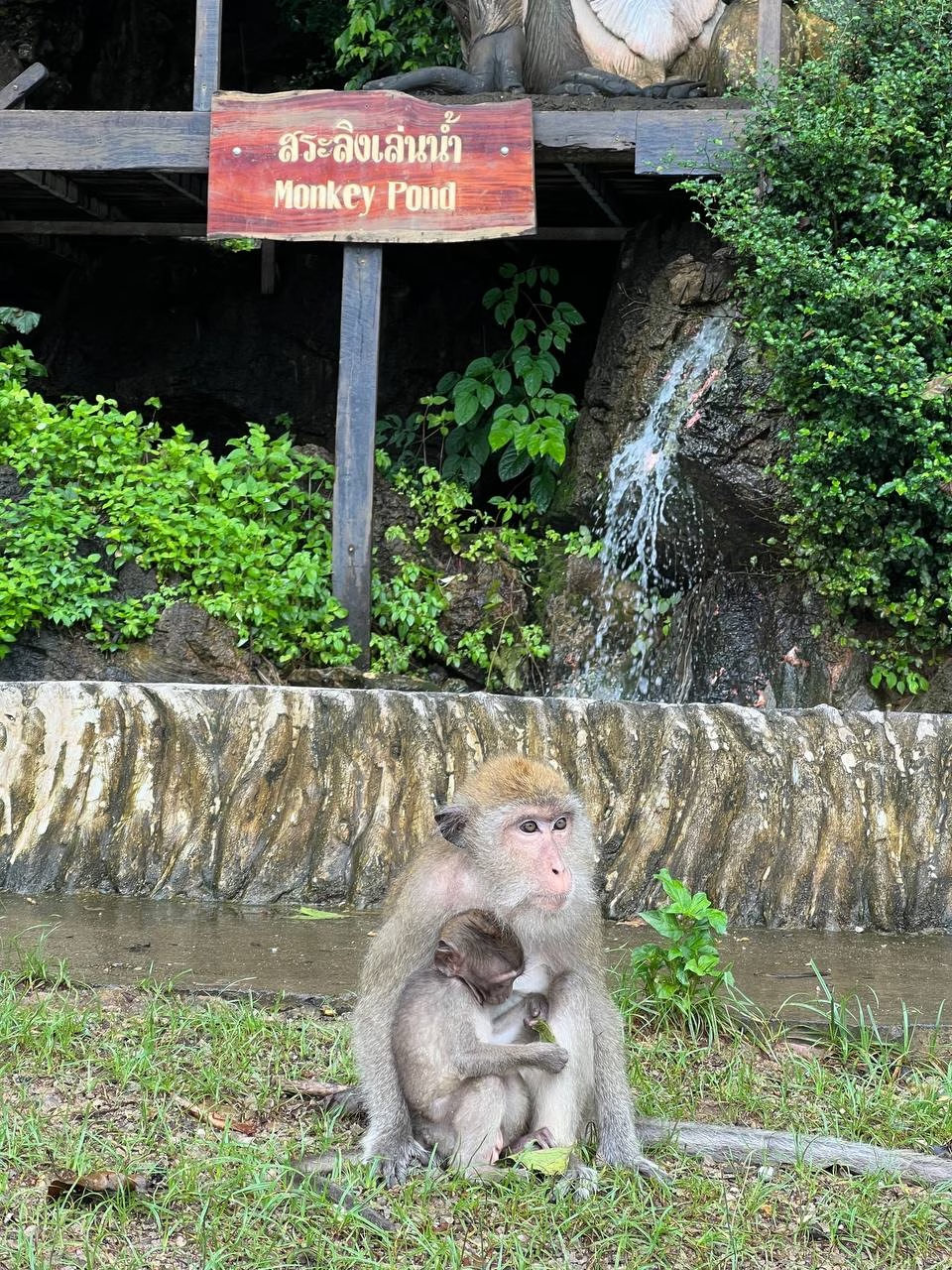
Check-in: The Cliff & River Jungle Resort
By afternoon, we reached The Cliff & River Jungle Resort just outside the park: a gorgeous jungle property threaded by a small river, with photogenic nooks everywhere to unwind, wander, and shoot. It’s peaceful, lush, and perfectly placed for night activities and the next day’s lake run.

Night trek + jungle cooking class (bamboo dinner!)
After a rest, we set out on a 3 km wildlife night walk with a local guide, then settled into one of the most memorable dinners of the trip: jungle cooking with bamboo. They lit the fire with dry bamboo, used bamboo tubes as pots to steam rice and soup, and showed us how to stuff vegetables and meat inside before sealing and roasting—aromatic, smoky, and totally authentic. We spotted classic Khao Sok nightlife on the trek: bats, big orb-weaver spiders, a dozy slow loris high in a tree, a small pit viper coiled on a branch, and the glinting eyes of frogs along the stream.
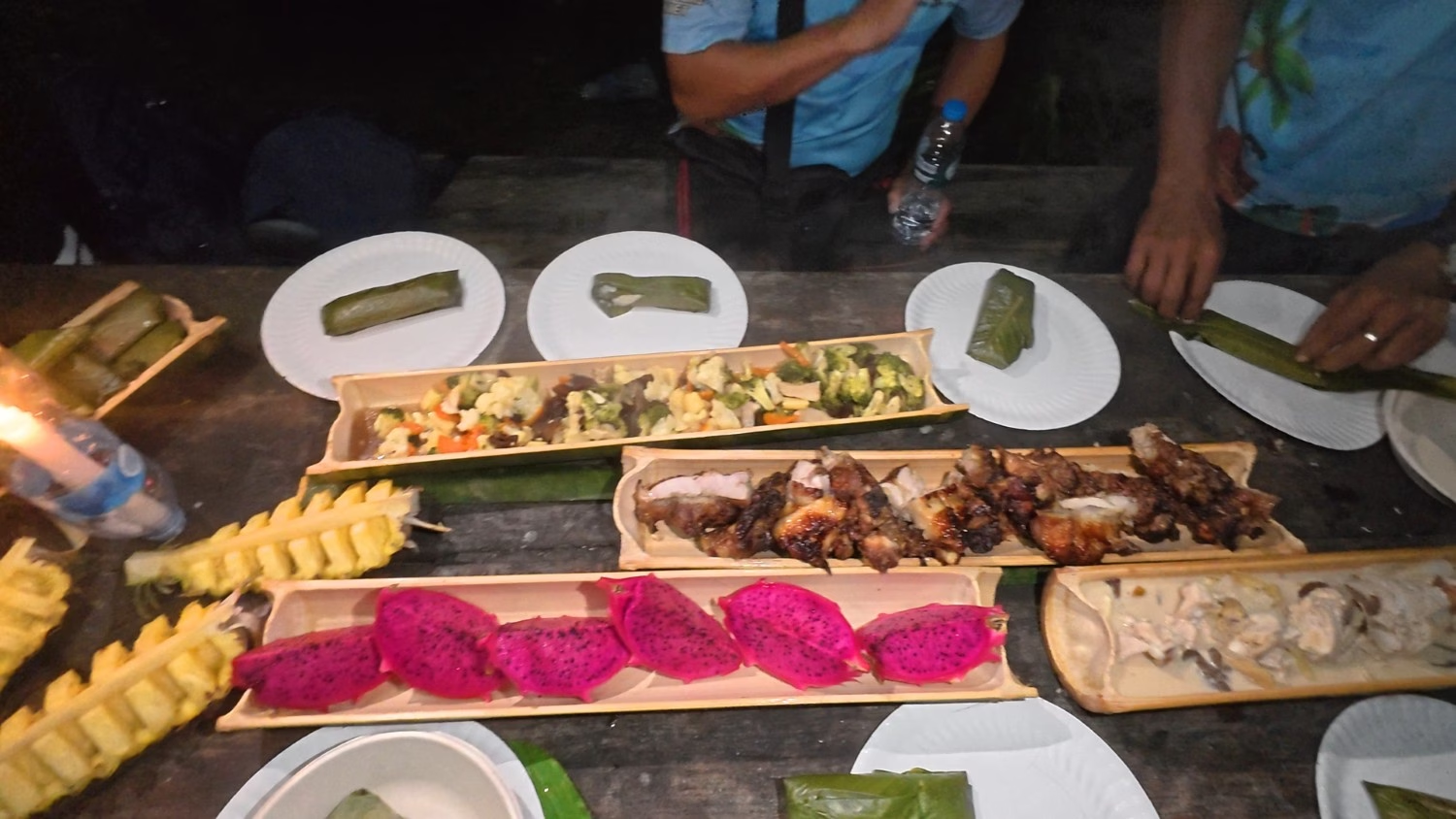
Day 2 — Cheow Lan Lake: Longtail boat, cave + rainforest trek, floating bungalows, kayak & swim
After breakfast, we drove to Ratchaprapha Dam pier and boarded a longtail boat onto Cheow Lan Lake—emerald water, sheer limestone walls, and the famous “Three Friends” rock trio rising out of the surface. It’s the moment Khao Sok really clicks. (Cheow Lan is the reservoir formed by the dam; the lake’s islands are former hilltops and the scenery is unreal.)
Cave + rainforest trek
We mixed a lake-to-trail combo—boat to the shore, then a guided jungle hike to a cave. Trails and caves change with water levels and seasons (some water caves close in heavy rain for safety), but the formula—boat ➝ hike ➝ cave ➝ boat—is the park classic and delivers that “lost world” feeling.
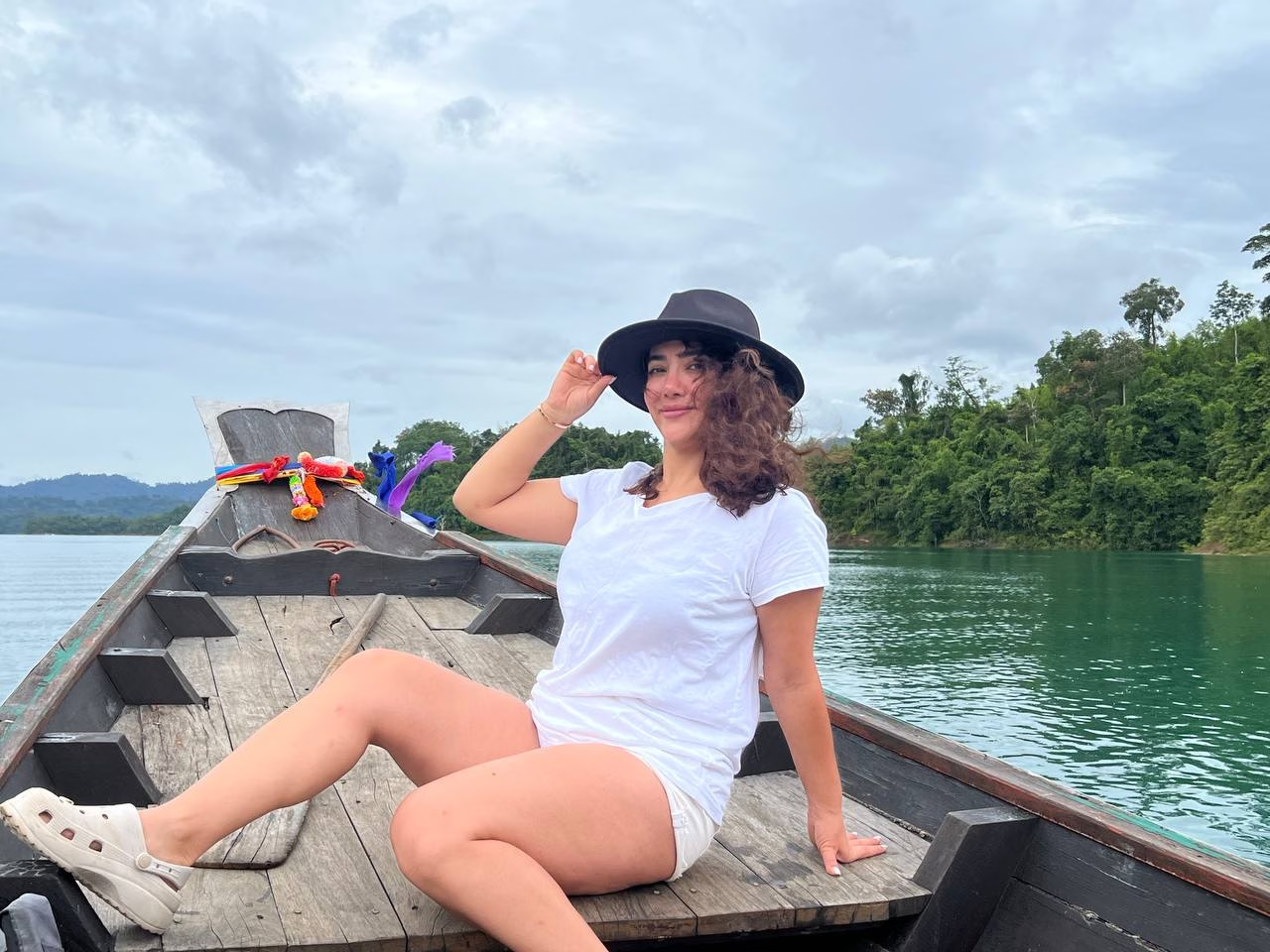
Floating bungalows overnight
We checked into floating bungalows in a quiet cove: front porch straight onto the lake, big picture windows and doors opening to the water, and steps leading right down for swims. Budget raft houses are simple; upscale options like 500 Rai or Panvaree add A/C, ensuite bathrooms, and resort comforts if you prefer. We spent the afternoon kayaking, swimming, and feeding fish that school under the walkways before dinner on the deck—Thai curries, grilled fish, fruit, and firefly-flecked darkness. Then that perfect Khao Sok night: absolute quiet, stars overhead, gentle water against the pontoons.
Day 3 — Bamboo rafting on Khlong Sok, temple stop, return to Phuket
Back on land after breakfast, we headed for bamboo rafting on the Khlong Sok River—a serene glide beneath jungle cliffs with a local captain poling us along. Midway we pulled ashore at a limestone overhang where the team boiled water inside a bamboo tube over an open fire and served tea in bamboo cups; and yes, we kept the cups as a souvenir (they last for years if you let them dry between uses). It’s a calm, family-friendly ride with birdlife, monitor lizards, and the occasional troop of monkeys along the banks.
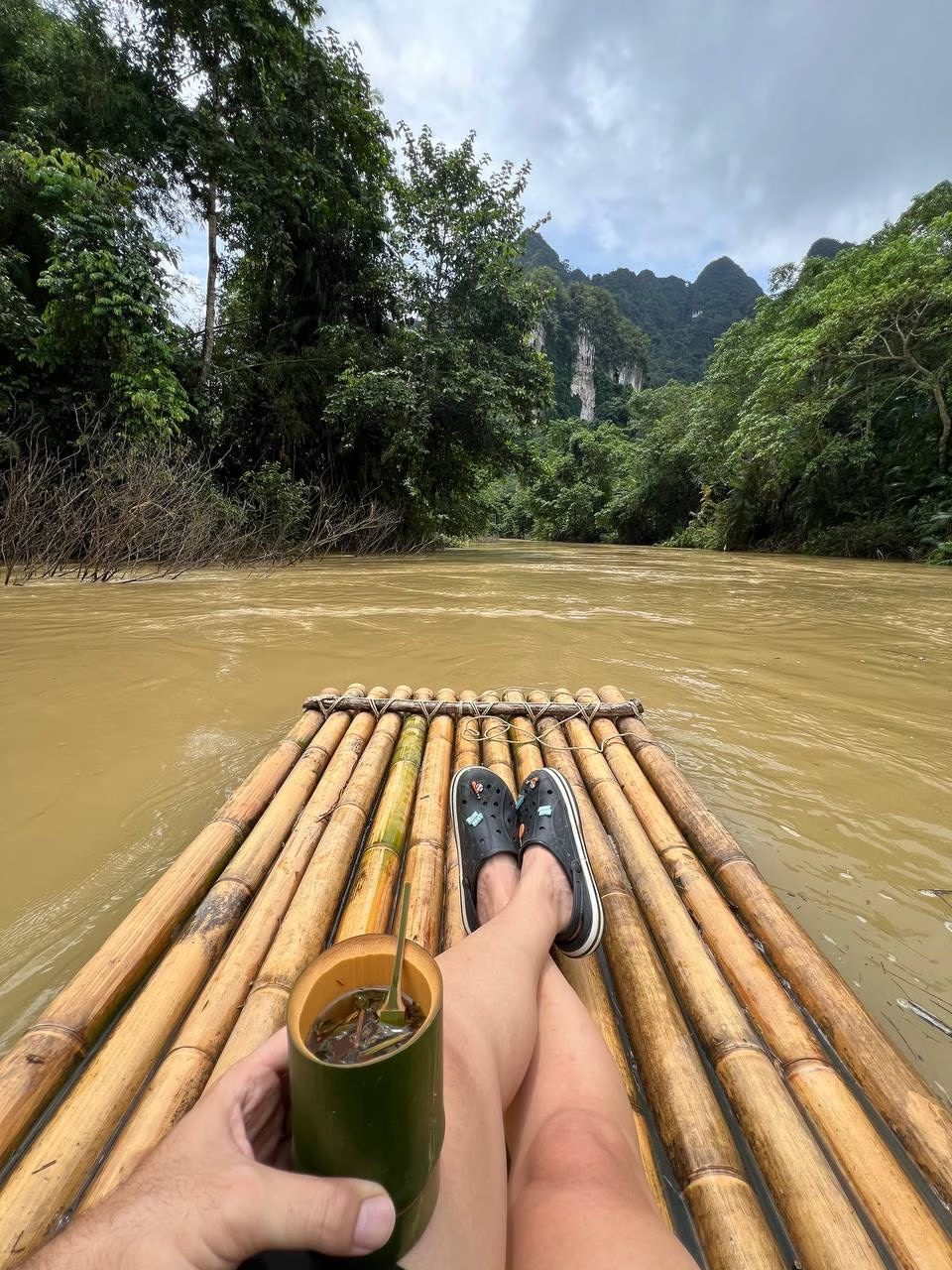
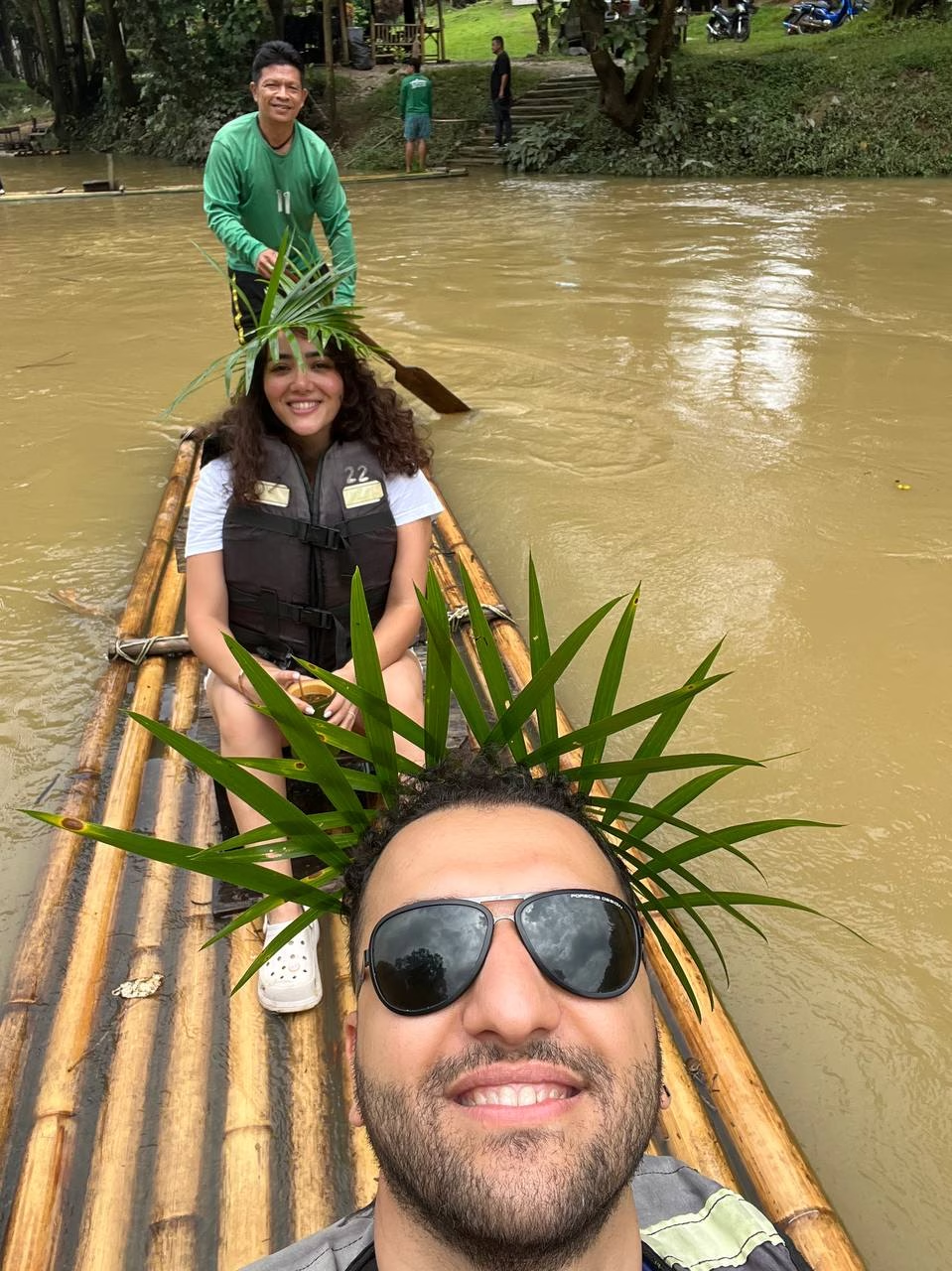
On the drive back toward Phuket, we made one more cultural stop at Wat Maha That Wachiramongkol (better known as Wat Bang Thong) in Ao Luek, Krabi—an awe-inspiring complex dominated by a ~95-meter golden chedi inspired by India’s Mahabodhi Temple at Bodh Gaya. Locals visit to make merit; when we arrived, we could hear chanting echoing through the cloisters while visitors circled the chedi clockwise in quiet reverence. It’s one of Southern Thailand’s most striking modern temples and an easy stop on this route.
We rolled back into Phuket in the evening—tired, happy, and already talking about when we can do it all again.
Top Things to Do in Khao Sok National Park
Whether you follow a tour itinerary or explore on your own, Khao Sok offers plenty of activities for nature lovers and adventure seekers. Here are some of the best things to do in Khao Sok:
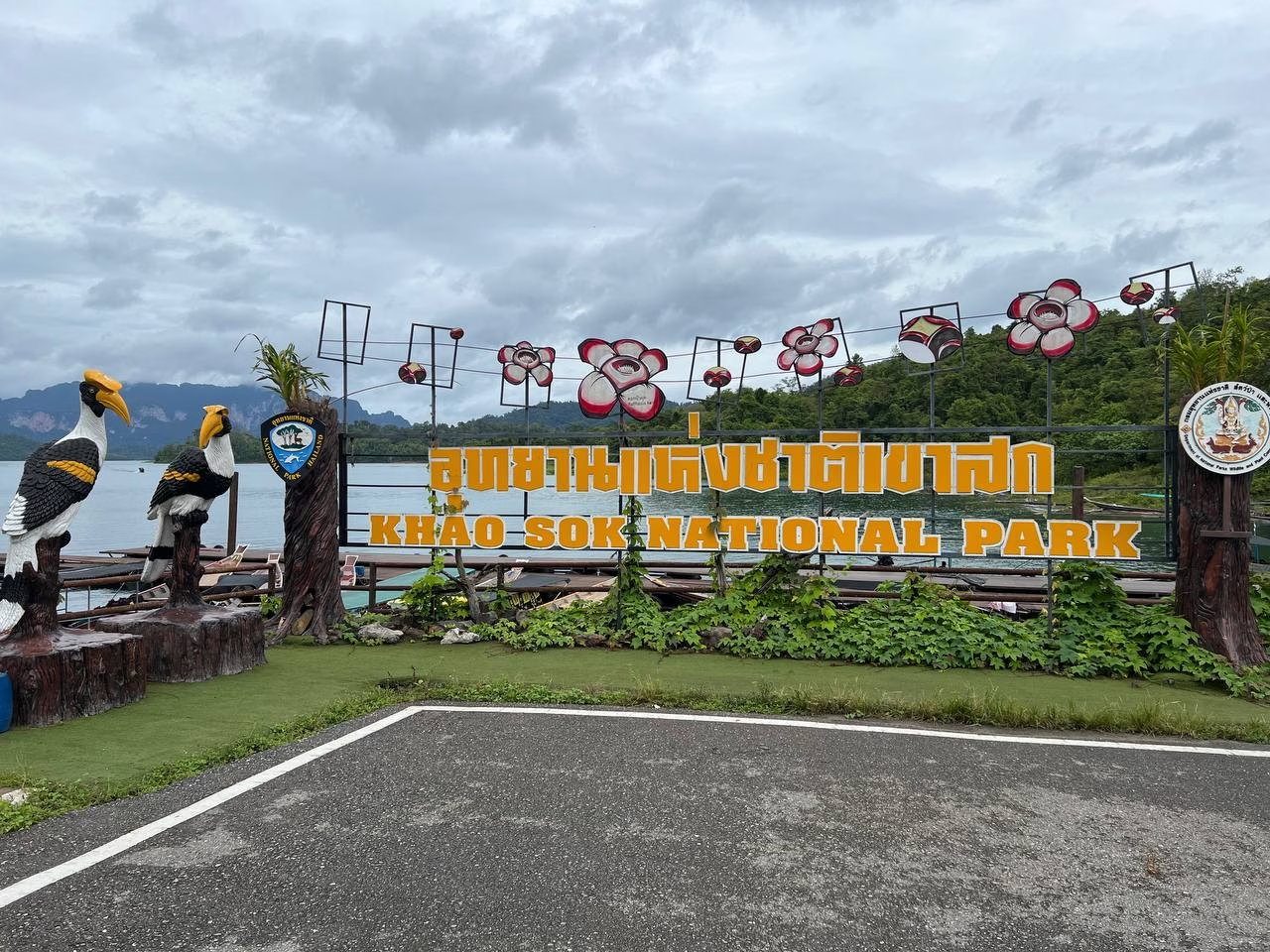
- Longtail Boat Tour on Cheow Lan Lake: The lake is the crown jewel of Khao Sok, and exploring it by boat is a must. Marvel at the limestone karsts, visit scenic spots like the “three friends” rocks, and enjoy the cool breeze as you cruise along the emerald waters. Boat tours can be day trips or include an overnight stay. Don’t forget to bring your camera – every turn reveals a new breathtaking panorama. Created in 1982 by the Ratchaprapha Dam, the lake is framed by limestone outcrops that rise to over 950 meters. If arranging your own boat locally, expect around 2,000 THB per day for a rental with a local captain. Classic stops include water caves and dry caves: Nam Talu (typically best/safer in dry season) and Tham Si Ru (once a communist hideout with four interlinked passages).
- Notable lake arms to explore:
- Khlong Long: On the northeast side, it offers a two-and-a-half-hour hike to limestone slopes, a cave, and a viewpoint; a handful of simple raft houses still exist here.
- Khlong Saeng: Remote arm about 25 km from the dam; permits required. Good for hiking, old mining sites, waterfalls, and wildlife (gibbons, deer, elephants, serow, great argus, and rare bears).
- Khlong Mon: Northern shore with shallow valleys and high ridgelines—prime hornbill and eagle habitat. Trails connect west toward Khlong Saeng, a short 5 km spur near the Tam Gia raft house.
- Stay in a Floating Bungalow: Spending a night (or two) in a floating raft house on Cheow Lan Lake is an unforgettable experience. It’s rustic and peaceful – a chance to disconnect (literally, since there’s no WiFi or cell service) and float in the middle of stunning nature. Enjoy swimming right from your porch, kayaking at sunset, and stargazing free from light pollution. If basic accommodation isn’t your style, a couple of upscale floating resorts like 500 Rai or Panvaree offer more comfort (think private bathrooms, electricity, even air-con), but they come at a higher price. Most travelers, however, find the simple bungalows more than worth it for one night – it’s the #1 highlight of Khao Sok for good reason.
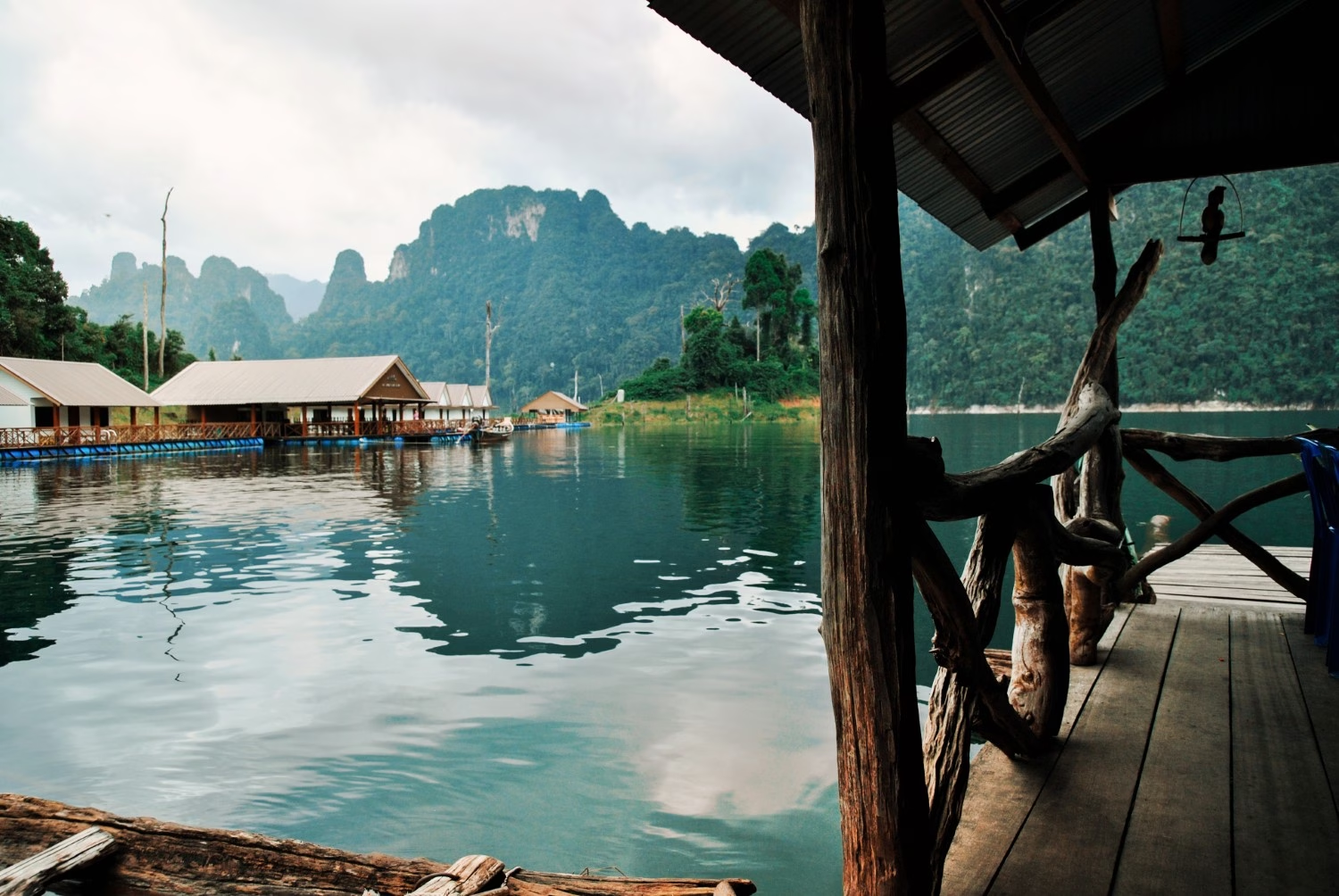
- Jungle Trekking & Hiking: Khao Sok’s rainforest is a hiker’s paradise. There are several trails near the park HQ that you can do with or without a guide, such as the Ton Kloi Waterfall trail (7 km one-way, passing multiple waterfalls) and shorter walks to caves like Kaew Cave. A guided jungle trek is highly recommended for first-timers – not only for safety, but because local guides can point out wildlife, edible plants, and hidden features you’d likely miss. During our trek, our guide showed us exotic insects and identified distant monkey calls. If you’re visiting in the rainy season, expect muddier trails (and leeches – bring leech socks or high boots, especially in wet months). The park is huge and dense, so never venture too far without informing someone; stick to marked trails or go with a guide. For Ton Kloi specifically, the trail follows the Sok River; the final ~4 km often benefits from a local guide, with smaller cascades, swimming holes, and gorge formations along the way before the main falls.
- Cave Exploration: Khao Sok has a number of caves. Nam Talu Cave is the adventurous one we described (involves wading through water) and is typically done as part of an overnight lake tour. Pakarang (Coral) Cave is a shorter, dry cave where you can see interesting calcite formations; it’s usually an easy add-on by boat. Near the HQ side, there is also Bang Hua Rat Cave and others accessible by hiking. Always inquire locally about conditions – some caves close in certain seasons for safety.
- Wildlife Spotting: While Khao Sok isn’t a guaranteed safari, it’s home to an impressive array of wildlife. Keep your eyes open for monkeys (long-tailed macaques often by the water, and dusky langurs deeper in the forest), gibbons heard whooping in the mornings, hornbills flying between treetops, and reptiles like monitor lizards or snakes. If you’re extremely lucky, you might spot a wild elephant on the far shores of the lake or evidence of one on a trail (they do live in the park in small numbers). For a better chance at wildlife, consider a Night Safari walk (more on that below) or an early morning guided walk. But even if larger animals elude you, the birdlife and smaller critters (butterflies, frogs, lizards) will keep nature enthusiasts happy. Pro tip: Bring binoculars for bird and monkey spotting.
- Night Safari in the Jungle: One of our favorite activities was the night walk organized by park rangers near the HQ. After dark, the jungle comes alive with creatures you’d never see in daytime. With a powerful flashlight in hand, a guide will lead you along a trail, pointing out glowing spider eyes, sleeping birds, and nocturnal species like civet cats, tarantulas, snakes, and even slow lorises if you’re lucky. It’s a bit spooky and absolutely thrilling to experience the rainforest at night – the chorus of insects and frogs is intense! We managed to spot a civet and a super-cute slow loris on our night safari, which was amazing. (These tours require a guide and an entry fee or ticket; if you go with a guide one evening and visit the lake the next day, your 300 THB park ticket covers both.) Just be sure to wear long pants and use insect repellent. And don’t worry – while you might see snakes curled on branches, they’re typically not aggressive if left alone.
- Canoeing or Tubing on the Sok River: In the village area, the Sok River winds through lush scenery, offering fun and relaxing water activities. You can join a guided canoe safari where a local paddler will navigate you downstream – this is a great way to quietly observe birds, monkeys, and even reptiles along the riverbanks (some travelers reported seeing snakes in overhanging trees and even otters). For a more freewheeling time, try river tubing – basically floating down the gentle river on an inner tube (available in the dry season when water levels are lower). We did tubing in the dry season; it was a bit slow and we had to occasionally push off shallow spots, but it was still a blast and a refreshing cooldown on a hot afternoon. Many guesthouses lend tubes or kayaks to guests for free or a small fee. Another option is bamboo rafting, where you sit on a bamboo raft steered by a guide – a short but serene ride that often includes a coffee break brewed in bamboo cups on an open fire. These river activities are perfect for families and can easily be done in a half day. Price anchors: tubing ~400–500 THB per person; canoe tour ~800 THB for ~2.5 hours; bamboo rafting ~1,200 THB for ~4 hours.
- Chasing Waterfalls: Khao Sok’s rainforest is dotted with waterfalls (most are modest in height but pretty, especially in rainy season when water flow is strongest). Popular ones include Mae Yai Waterfall (a short walk from the main trail) and the endpoint Ton Kloi Waterfall, which is about 7 km in from the visitor center if you hike the whole trail. Visiting waterfalls is best in the Green Season (May–Oct) when they aren’t dried up. Just note that trails can be slippery then. We visited in dry season and most small falls were just trickles, so we skipped the waterfall trek – but if you’re there in the wet months, a jungle waterfall swim would be awesome.
- See the Rafflesia (world’s largest flower): If you happen to visit between November and April, ask about the Rafflesia bloom. Khao Sok is one of the few places in Thailand where Rafflesia kerrii is found – this gigantic red flower can be nearly 1 meter in diameter! It blooms for just a few days and emits a famously foul odor to attract insects. We didn’t get to do this, but there is a specific trail to see the Rafflesia (with a guide) when it’s in bloom. It’s a 4-5 hour round-trip hike, but how often do you get to see the world’s largest flower in the wild? If you’re visiting in season and love botany or unique claims-to-fame, it’s worth inquiring at the park HQ.
- Local Village Experiences: Aside from nature, the Khao Sok village area offers some low-key cultural and fun activities. You can take a Thai cooking class (often held at jungle lodges like Our Jungle Camp) to learn how to whip up pad thai or curry in an open-air kitchen. We did a short cooking class one evening and enjoyed it – making papaya salad and coconut soup while overlooking the river was delightful. Some lodges also offer massage services, which are welcome after a day of hiking. You might also visit local fruit farms or ethical animal sanctuaries (if doing any elephant activity, ensure it’s observation-only; avoid any camps that allow riding or bathing of elephants, as those are not truly ethical).
In short, you can pack your days with adventure or take it slow in Khao Sok. We loved combining a bit of adrenaline (caving, hiking) with lazy enjoyment (tubing, swimming, hanging in a hammock, listening to nature). Plan according to your interests and time – even one full day can show you a lot, but 3 days would let you experience both the lake and the rainforest more fully.
Wildlife of Khao Sok: What to Expect
A dusky langur (spectacled leaf monkey) peering through the foliage in Khao Sok National Park. These gentle primates, with their distinctive white eye-rings, are one of many wild inhabitants of the park.
One of the reasons Khao Sok draws nature enthusiasts is the promise of wildlife in an untouched habitat. The park indeed boasts an impressive list of animals – including Asian elephants, sambar deer, wild boar, bears, guar (bison), serow (goat-antelope), macaque monkeys, langurs, gibbons, and more. There are even occasional reports of elusive species like clouded leopards or a very rare black panther sighting, though you’d have to be extraordinarily lucky to encounter those. Tigers are often rumored to exist here, but according to park officials, there’s no concrete evidence of tigers remaining in Khao Sok (historic records exist, but none have been confirmed in recent decades).
In total, Khao Sok is home to over 50 mammal species, more than 310 bird species, and around 30 bat species, along with diverse reptiles, amphibians, and insects.
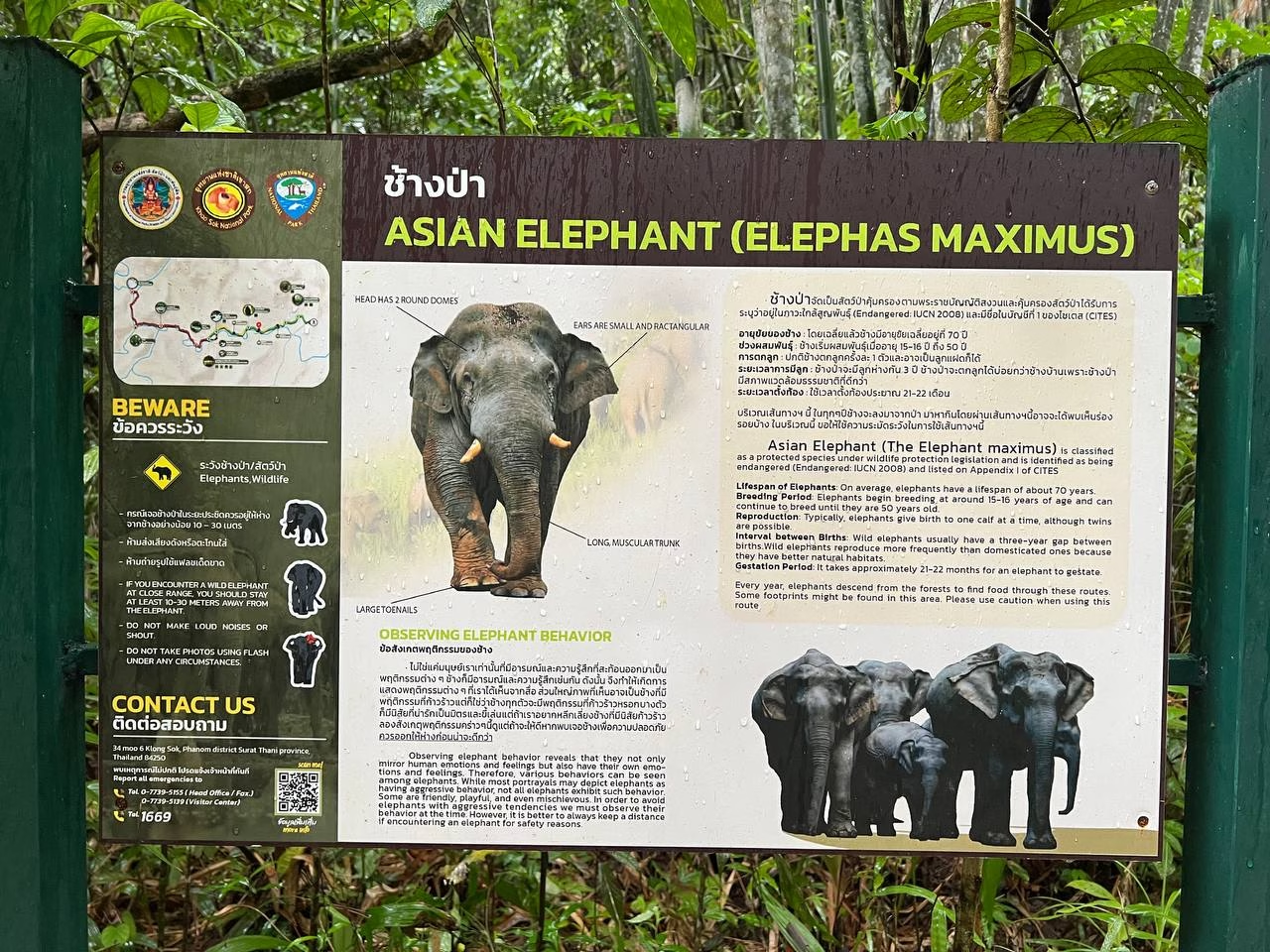
That said, temper your expectations when it comes to wildlife sightings. Khao Sok is a dense rainforest, and animals have plenty of space to hide. This isn’t like an African safari where large animals are easily observed in open plains. During our trip, our personal sightings were modest – we saw monkeys, hornbills, some lizards, and heard gibbons. Around the lake, we mainly spotted macaques on the shore and some hornbills flying overhead. The lake areas can actually feel surprisingly devoid of wildlife at times
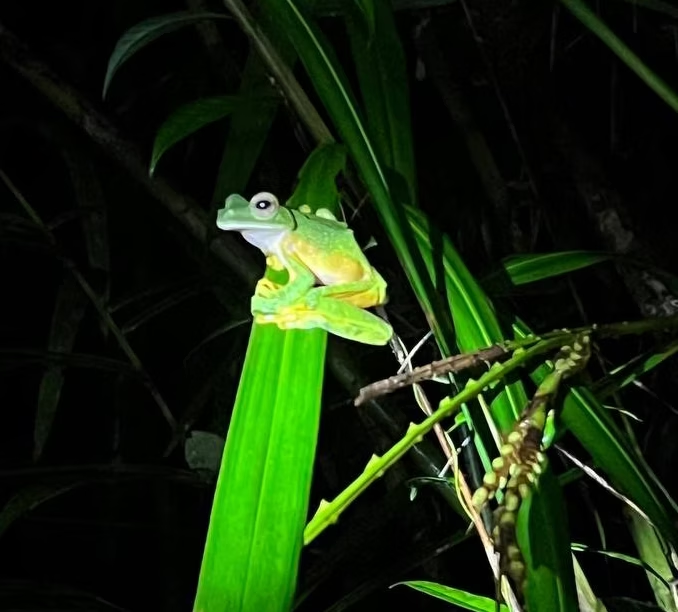
(fun fact: we encountered almost no mosquitoes on the lake, which is unusual for a tropical area, possibly because fish in the reservoir eat the larvae!). If you visit Khao Sok expecting a jungle teeming with visible animals at every turn, you might be a bit disappointed, as one travel blogger cautioned. However, the animals are out there – it often takes patience and the right timing to see them.
For better chances, consider these tips:
- Go on a guided night walk or early morning walk: Nocturnal creatures like civets, porcupines, slow lorises, and snakes are more active at night. Early morning (just after sunrise) is best to hear and possibly see gibbons and birds when they’re most active. Our dawn boat ride yielded monkey and hornbill sightings that we wouldn’t have had later in the day.
- Explore both the lake and the trails near HQ: Wildlife near the park headquarters (on the mainland trails) can be richer than around the lake itself. Hikers near HQ often see dusky langurs (leaf monkeys) quietly munching leaves in the trees, or hear gibbon calls. Near rivers, people have spotted otters and various birds. If you venture on the longer trails or take a full-day hike with a ranger, you increase the chance of encountering something big (there are wild elephants deep in the park; some lucky visitors have seen one at a salt lick or near the far end of the lake). Always keep a safe distance and never approach wild elephants – they can be dangerous if surprised or provoked.
- Birdwatching: With over 300 bird species recorded, Khao Sok is a paradise for birdwatchers. Even if you’re not a “birder,” you’ll likely notice the great hornbills (huge birds with yellow beaks and a whooshing wingbeat sound) and the smaller Oriental pied hornbills, both present here. Kingfishers, eagles, egrets, and bulbuls are commonly seen. Bringing binoculars or a camera with a zoom will enhance your wildlife experience tremendously.
- Insects & Reptiles: Don’t overlook the little guys. Khao Sok has fascinating insects – giant butterflies, exotic stick insects, and gliding lizards (Draco lizards that can fly from tree to tree). On our night walk, we saw a tarantula peeking out of its burrow and a flying dragon lizard sleeping on a trunk. During the day, you might see colorful spiders or if you’re very fortunate, the rare Rafflesia flower, as mentioned (which technically counts as flora but is a huge draw for nature geeks).
In summary, expect quality over quantity with wildlife. You may have long stretches where you mainly see beautiful forest and hear sounds, punctuated by a few thrilling moments when a creature reveals itself. And that’s part of the magic – Khao Sok is true wilderness in many ways, not a zoo. Even if you don’t spot a wild elephant or a bear, just knowing they roam these forests adds to the sense of adventure. For hardcore wildlife enthusiasts, a guide can arrange multi-day treks deeper into the jungle – but for the average visitor on a short trip, enjoy the common sightings (monkeys, birds, reptiles) and consider any rare animal encounter the cherry on top. One tip: check out the wildlife chalkboard at the park HQ (if they have one) or ask rangers what’s been seen lately; they sometimes post recent elephant sightings or interesting events.
Oh, and watch out for the leeches in the wet season – those little suckers are part of the wildlife too! They’re mostly harmless (just annoying) and actually don’t transmit diseases, but wearing leech socks can save you some “surprise” blood stains on your socks.
Flora of Khao Sok
Large portions of Khao Sok are cloaked in tropical evergreen and rainforest vegetation. With nearly 200 floral varieties per hectare, the biodiversity here is truly astounding. Among the notable species are the giant Rafflesia, intricate pitcher plants, bamboo groves, dipterocarp trees, figs, swaying coconut palms, and robust lianas. These lush greens not only create a vibrant ecosystem but also provide visitors with a unique botanical experience.
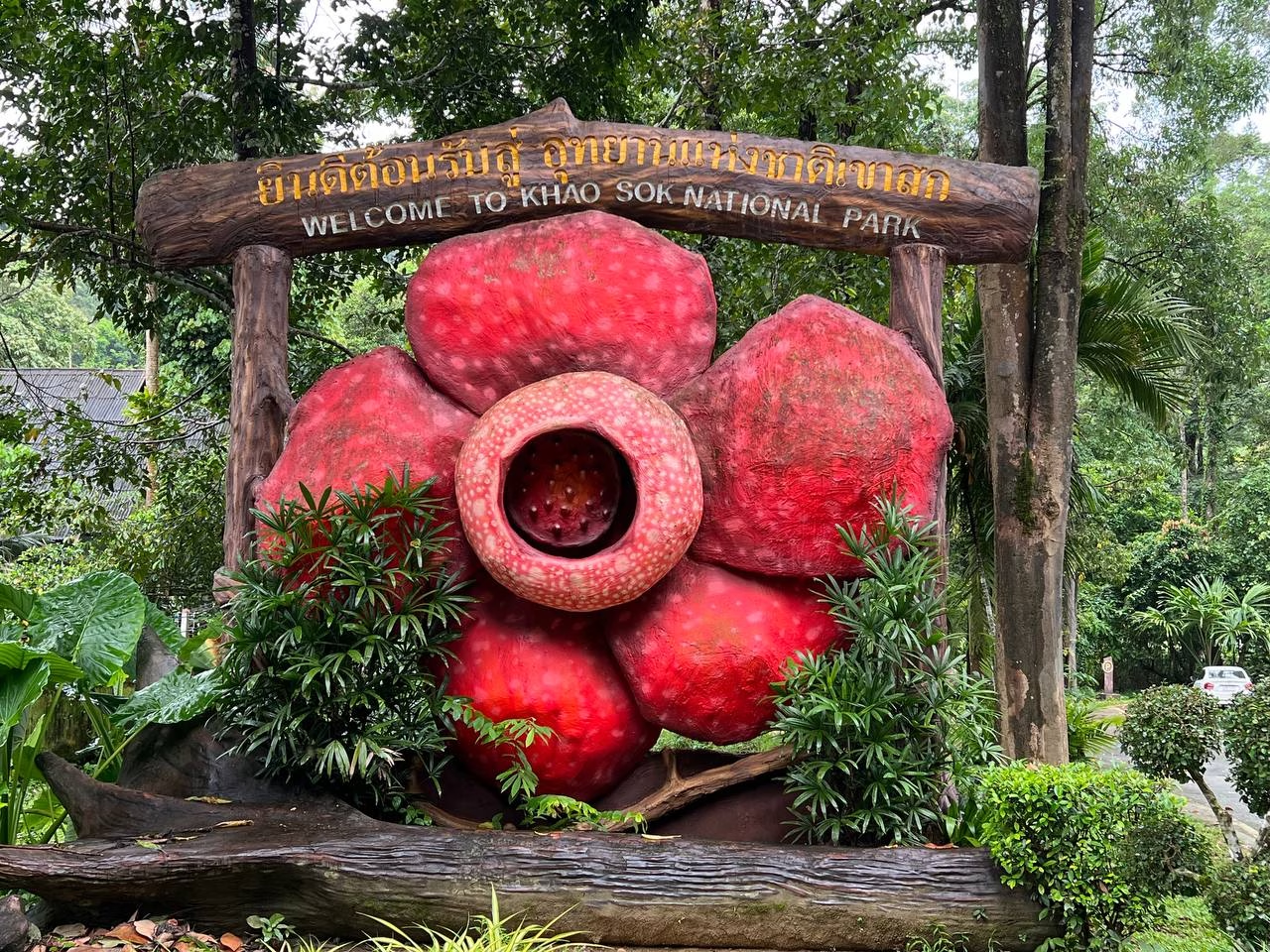
Best Time to Visit Khao Sok
Khao Sok is open year-round, but the experience can vary with the seasons:
Dry Season (Approximately November to April)
This is generally the best time to visit in terms of weather. Days are warm and mostly sunny, and trails are less muddy. December through February are particularly lovely with slightly cooler temperatures at night. This period is also peak tourist season, meaning tours and accommodations can fill up – booking in advance is wise. By March-April, it gets hotter. The dry season is ideal for boating and cave exploration (cave treks like Nam Talu are usually open when water levels are low). The downside is some waterfalls might be just a trickle, and the jungle won’t look as lush green as in the rainy months. But overall, for ease of activities and comfort, dry season is prime.
Rainy Season (May to October)
Also called the “green season” or monsoon season. Expect frequent rain (especially May, September, and October being the wettest). The upside is the rainforest is at its most lush and vibrant, waterfalls are gushing, and you’ll encounter far fewer tourists. The scenery can be extra dramatic with mist and clouds entangling the cliffs. Wildlife might be more active (though also more spread out due to abundant water). If you don’t mind occasional downpours and some schedule flexibility, this season has its charm – and often you can score better prices on tours. However, note that some activities might be limited by weather: Nam Talu Cave for instance, is usually closed for safety in wet months, as flash floods can occur inside. Leech populations boom (bring leech socks!). Also, boat tours might cancel if there’s very severe weather or if the dam authorities restrict lake access due to storms. That said, many travelers do visit in rainier months and still have a fantastic time – just come prepared for rain gear and a sense of adventure. Often the rain comes in short afternoon bursts, with mornings and evenings still pleasant.
Shoulder Months
Late November and May are transition times. You might get a mix of rain and sun. We went in January, and it was dry and sunny for us, with cool mornings – wonderful conditions for everything.
One special thing to consider is wildlife seasonality: The Rafflesia flower blooms roughly November-April (with peaks around January/February), so if seeing that is on your bucket list, don’t come in say, July. Conversely, if you’re a birder, migratory birds might be around in certain months. But generally, there’s no bad time for wildlife – it’s more about your comfort with rain/heat.
In summary, December-February likely offers the best weather combo (dry, not too hot). March-April gets hotter but still dry; May-Oct brings rain and a more secluded experience. Whenever you go, pack accordingly and you’ll enjoy Khao Sok’s magic in its own unique way.
(Fun fact: Khao Sok is among the wettest spots in Thailand, with up to 3,500 mm of rain a year in some areas, due to monsoons from both the Gulf and Andaman sides. No wonder it’s so green!)
Travel Tips for Khao Sok National Park
To make the most of your trip, keep these practical tips in mind:
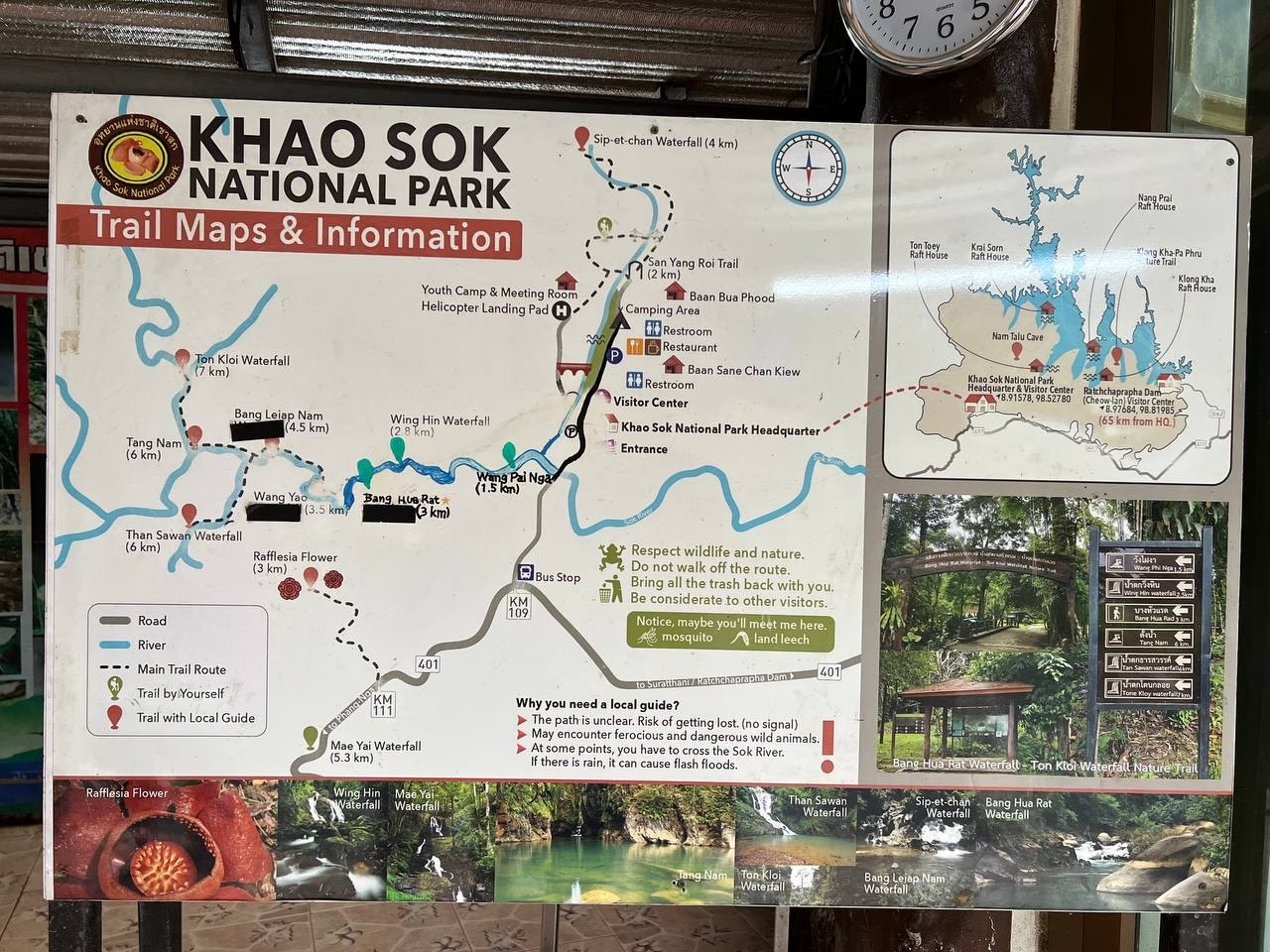
Entrance Fees
The park charges an entry fee of 300 THB per adult foreigner (150 THB for kids), which covers 24 hours in the park. If you’re doing an overnight tour, this fee is usually included in your tour package (ours was included, but double-check). There is also a 40 THB per person fee at the pier for lake maintenance, and certain caves like Coral Cave have a small fee (200 THB). Bring cash for these local fees and for any drinks/snacks you might buy.
What to Pack
Think outdoorsy and casual. Essentials include mosquito repellent (especially in the village/jungle areas, though less needed on the lake), sunscreen, a hat, and lightweight long clothing for hikes (to guard against insects and sun). Good walking shoes or hiking sandals are a must – the trails can be muddy and rocky. If you plan to do the cave trek or tubing, water shoes or old sneakers that can get wet are very useful (you can rent rubber shoes there too if needed). A dry bag will save your camera/phone on boat rides or in the cave. Also pack a swimsuit (you’ll regret it if you can’t jump in that beautiful lake!), a quick-dry towel, and a change of clothes. A small flashlight or headlamp is handy at night (especially if staying in raft houses with limited lighting).
Lastly, if visiting in the rainy season: rain gear (poncho or quick-dry jacket) and possibly leech socks (tall sock-like gaiters) for trekking – leeches aren’t dangerous but can be an unpleasant surprise on your ankles.
Health & Safety
Khao Sok is a generally safe destination. The main things are natural risks – slippery trails, some stinging insects perhaps, and the fact that you’re in wild terrain. Stay with your group or on marked paths, especially around the lake (the jungle is not easy to bushwhack through!). If you have mobility issues, note that the raft houses have floating pontoons that can wobble a bit, and reaching some (like ours) involved climbing a few steep steps on a hillside to the toilet/shower area. For the cave, you should be reasonably fit and OK with water and dark confined spaces; if not, you can usually opt out and do an alternate activity like kayaking while others do the cave. Regarding wildlife, do not feed monkeys (they can get aggressive), and secure any food in your bag – monkeys have been known to snatch unattended snacks. Malaria risk in this part of Thailand is very low; just avoid mosquito bites to be safe (dengue fever is present in Thailand, though we encountered hardly any mosquitoes by the lake). We recommend having travel insurance that covers adventurous activities just in case. Do not explore unknown paths without a knowledgeable guide.
Facilities & Electricity
If you stay overnight on the lake in basic bungalows, be prepared for minimal electricity. Many raft houses run generators only for a few hours at night for lighting. Don’t count on being able to charge devices except maybe at the main restaurant area and only during generator hours. It’s wise to bring a power bank if you need to recharge cameras/phones (though honestly, being off-grid for 24 hours is refreshing!). At our raft house, there were a couple of hours of power in the evening, then lights out – which was fine for one night. In Khao Sok village, most guesthouses have normal electricity and sometimes WiFi, though cell signal can be weak in the valley.
ATMs and Money
There are ATMs in Khao Sok village, but none out at the lake. Bring enough cash to cover your expenses (drinks, tips, souvenirs) while at the lake or on tours. Most tours include meals, but you pay extra for things like beer, soda, etc. Our raft house had beer for sale (at a slight premium, but understandable given everything is brought by boat). Tipping guides and boat drivers is appreciated – not mandatory, but if they did a great job, a few hundred baht shared among the team is a nice gesture.
Accommodation Choices
If you have more time in Khao Sok, consider spending a night in Khao Sok Village in addition to (or instead of) the lake. The village has unique jungle lodges like Our Jungle House or Our Jungle Camp, where you can sleep in a treehouse or riverside bungalow surrounded by nature. We stayed one night at Our Jungle Camp and loved hearing wildlife at night – we even saw a mangrove snake and an owl on the property. Staying in the village allows you to do day hikes, night safaris, river activities, and also have a bit more comfort (hot showers, fans, a variety of restaurants in town). Then you can do a separate overnight on the lake for that experience. If short on time, some choose just one base: either one long day trip to the lake (coming back same day) or staying in a jungle lodge and day-tripping to the lake. But doing both was the best of both worlds for us.
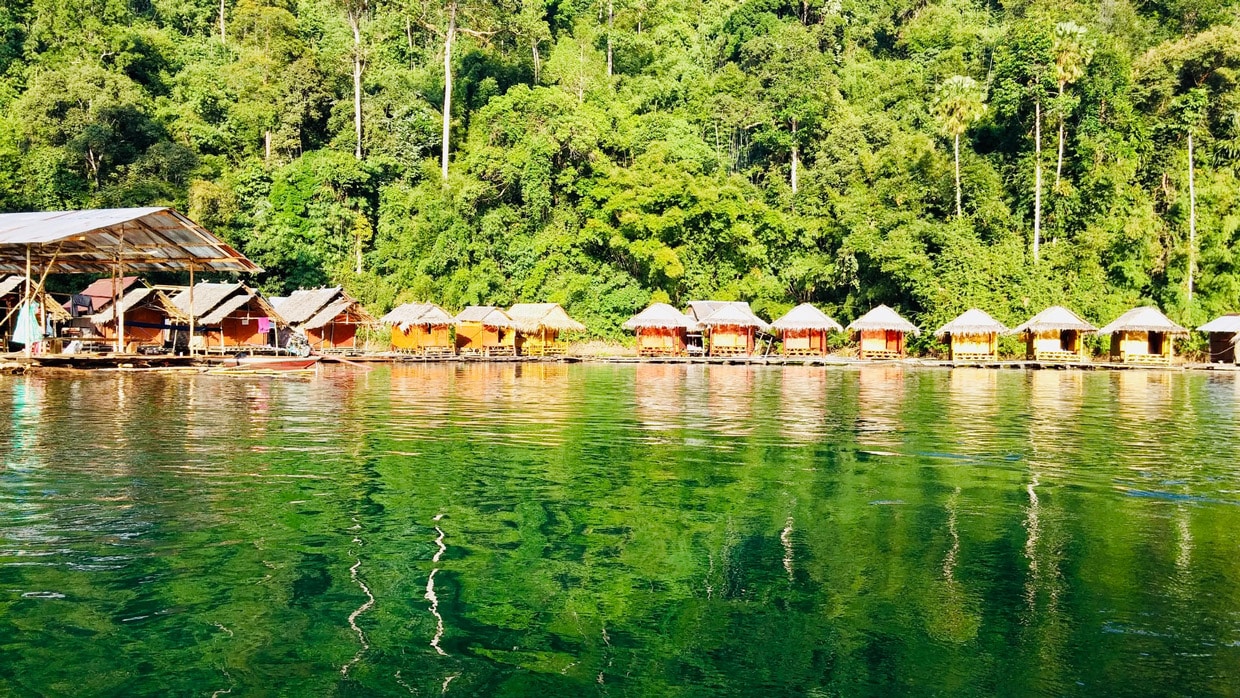
For a different experience, consider camping near the park’s entrance. The campsite has basic facilities (toilets, showers, and a small café), and you can rent tents, pillows, blankets, and sleeping bags for a nominal fee.
Connecting to Other Destinations
Khao Sok pairs well with visits to the Andaman coast. Many travelers come via Phuket or Krabi, and after Khao Sok, continue to places like Khao Lak (beaches), or head east to Surat Thani to catch ferries to the Gulf islands (Koh Samui, Koh Phangan). We went back to Phuket because that’s where we started, but logistically you can go any which way – just ask tour operators or your guesthouse to help arrange onward transport. There are daily buses that pass Khao Sok on the north-south highway, which can take you towards Bangkok or down towards Hat Yai as well.
Guided Tour vs. DIY
We found that a guided tour made everything easy, especially with limited time. It included transfers, activities, a guide who provided a lot of info, and the park fees. If you’re an independent traveler, you can absolutely do Khao Sok on your own too – perhaps stay in the village, hire a local guide for a day hike, and book a 1-day lake tour separately. This might save money and give more flexibility, especially if you want to avoid the more touristy aspects. On the flip side, the group tours (we booked through our hotel and it was similar to ones on GetYourGuide) are convenient and a great way to meet fellow travelers. For families, an organized tour is hassle-free. Just pick a tour that matches your comfort level – some have bigger groups in basic bungalows, while others, like Elephant Hills, offer a more intimate group and luxury tents/camps (with a price tag to match). Read recent reviews to choose what’s right for you.
Responsible Travel
Lastly, help keep Khao Sok pristine. Don’t litter (pack out all trash, including cigarette butts). Avoid soaps or shampoos in the lake (they can harm the fish). Observe wildlife respectfully – no loud noises or chasing animals for photos. And as mentioned, be wary of any wildlife “sanctuary” experiences. If your itinerary includes an elephant camp, ensure it’s ethical (no riding, no performing tricks). A well-known option is the Elephant Hills camp, which allows you to observe and feed elephants responsibly without exploitative practices. Khao Sok’s charm is its wild nature, so let’s keep it that way by traveling mindfully.
By following these tips, you’ll be well-prepared and can focus on enjoying the adventure!
Who Should Visit Khao Sok?
In our opinion, almost anyone with a love for nature will be thrilled by Khao Sok – but here are some specific perspectives:
First-Time Visitors to Thailand
If you want to go beyond beaches and temples to see a wild, untamed side of Thailand, Khao Sok is perfect. It’s easily accessible from tourist hotspots yet feels a world away from the crowds. Even if you have a shorter holiday, including a 2-day Khao Sok side trip can greatly enrich your experience. Just be aware it does require at least an overnight commitment to do it justice (day trips are possible but very rushed). If you only have two weeks in Thailand, many travelers say Khao Sok ended up being their favorite part for its sheer beauty.
Families
Yes – Khao Sok can be family-friendly! We saw families with kids ranging from toddlers to teenagers on the lake and at the lodges. Kids generally love boat rides and swimming, and easy nature walks. Many tours and resorts cater to families by providing life jackets, kid-friendly meals, etc. Just choose activities suitable for your child’s age (e.g., maybe skip the Nam Talu water cave if you have young kids or anyone who isn’t a confident swimmer – some tours route families to a safer cave or a shorter hike instead). The excitement of sleeping in a floating hut and spotting monkeys is something kids will remember forever. Do pack child-sized rain gear and snacks, as options are limited once you’re out in the park. Also, families might consider self-driving to Khao Sok for flexibility – the roads are decent and having a car means you can explore at your own pace (many families did so, as renting a car in Thailand is straightforward).
Backpackers and Budget Travelers
Khao Sok fits nicely into a backpacking route. It’s not as dirt-cheap as some Thai destinations (tours can be a bit pricey for tight budgets, around $70 and up for overnight including everything), but doing it independently can save money (stay in a budget bungalow for $10-15, do a day lake tour for ~$40). There are hostels and cheap eats in the village, and you can team up with other backpackers to hire guides together. The reward-to-cost ratio is high – you get an experience that looks like a million bucks without spending it. Plus, it’s a nice break from party scenes if you’ve been on the islands.
Adventure Seekers
If you crave adventure, Khao Sok delivers in a soft-core kind of way. It’s not a hardcore expedition (since tours handle a lot), but within a short trip you can trek through jungles, climb waterfalls using ropes, spelunk through caves, and kayak in remote rivers. It’s an adventure accessible to non-experts. For an extra adrenaline rush, some extended treks (3-4 days camping in the jungle) are offered by specialist guides – those can get rugged and are for enthusiasts who want to venture off the beaten path. But for most, the standard activities will quench your thirst for excitement while still feeling safe and organized. We found it to be the perfect balance of thrills and comfort.
Photographers & Nature Lovers
Khao Sok is a dream if you’re into landscape or wildlife photography. Bring those cameras – sunrise and sunset on the lake are phenomenal, and the misty mornings in the rainforest are atmospheric. Even at midday, the colors of the lake and jungle are vibrant. We had a field day taking photos of limestone cliffs, weird insects, and each other jumping into the water with GoPros. Just remember to waterproof your gear (humid and wet conditions!). Birdwatchers and plant enthusiasts will also be in heaven, given the biodiversity. Allowing an extra day to wander slowly (rather than a packed tour schedule) can be beneficial if photography is a priority.
Those Seeking Relaxation
You might wonder, with all this talk of trekking and adventure, is Khao Sok a place to relax? Absolutely. In fact, we met a couple who didn’t do any hardcore activities – they simply stayed in a nice river lodge, did a gentle boat tour and a short hike, and spent the rest of the time swinging in hammocks and enjoying the scenery. Khao Sok can be very tranquil, especially compared to crowded beach towns. The village has a laid-back vibe; the jungle has calming sounds. If you’re not into intense physical stuff, you can still enjoy Khao Sok by focusing on scenic and easy options (like short nature trails, boat cruise, tubing). So don’t be deterred if you’re not an “adventurer” – Khao Sok’s peace and natural beauty can be restorative for anyone.
Not for…
The only people I’d say might not enjoy Khao Sok are those who truly hate bugs, rain, or rustic conditions. If camping or countryside makes you miserable, a floating bungalow with cold water showers might not spark joy (maybe consider a day trip only, or staying in a higher-end resort). Also, if your schedule is extremely tight, skipping Khao Sok is understandable – it does demand some transit time. But if you have even one night to spare, it’s so worth it.
To sum up, Khao Sok is ideal for couples, solo travelers, friend groups, young and old – anyone who appreciates nature’s grandeur. We found a wonderful mix of people on our tour: honeymooners, backpackers, a family with grandparents and kids, and everyone got something memorable out of it. As one article put it, Khao Sok is “perfect for those who want their holidays to include both hammocks and hiking boots.” and we couldn’t agree more.
